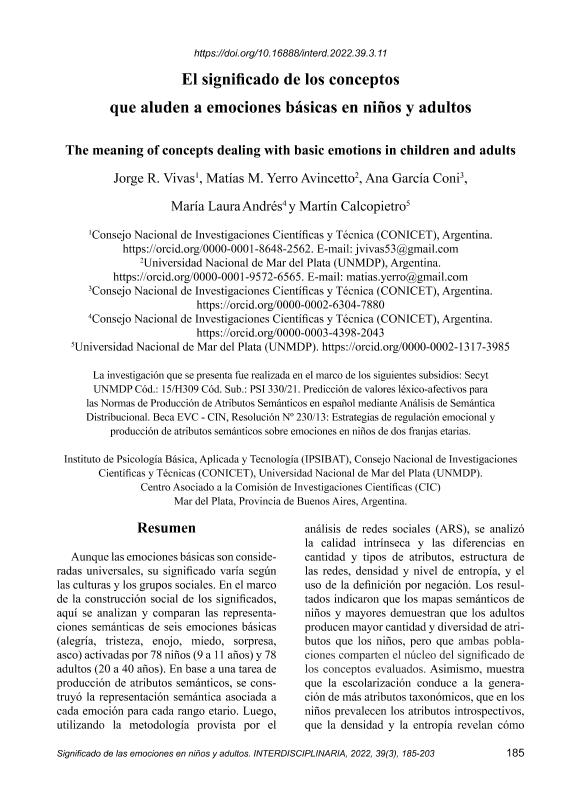Artículo
Aunque las emociones básicas son consideradas universales, su significado varía según las culturas y los grupos sociales. En el marco de la construcción social de los significados, aquí se analizan y comparan las representaciones semánticas de seis emociones básicas (alegría, tristeza, enojo, miedo, sorpresa, asco) activadas por 78 niños (9 a 11 años) y 78 adultos (20 a 40 años). En base a una tarea de producción de atributos semánticos, se construyó la representación semántica asociada a cada emoción para cada rango etario. Luego, utilizando la metodología provista por el análisis de redes sociales (ARS), se analizó la calidad intrínseca y las diferencias en cantidad y tipos de atributos, estructura de las redes, densidad y nivel de entropía, y el uso de la definición por negación. Los resultados indicaron que los mapas semánticos de niños y mayores demuestran que los adultos producen mayor cantidad y diversidad de atributos que los niños, pero que ambas poblaciones comparten el núcleo del significado de los conceptos evaluados. Asimismo, muestra que la escolarización conduce a la generación de más atributos taxonómicos, que en los niños prevalecen los atributos introspectivos, que la densidad y la entropía revelan cómo los conceptos se vinculan entre sí diferencialmente en ambas poblaciones y finalmente que, frente a la dificultad para encontrar definidoras de pertenencia a una clase, los niños recurren a operaciones de contraste categorial. Entre las redes semánticas de adultos y de niños se encuentran continuidades y divergencias. En ambos grupos se encuentran separadas las emociones positivas de las negativas, lo cual es consistente con las teorías que sostienen la importancia de la valencia hedónica en la comprensión de las emociones. Although basic emotions are considered universal, their representation, associations and meaning vary among cultures and social groups. Within the framework of the socio-constructivist theory, where the meanings develop in the social context, this paper analyzes and compares the semantic representations of six basic emotions (Joy, Sadness, Anger, Fear, Surprise and Disgust), evoked by 78 children between 9 and 11 years old and 78 adults between 20 and 40 years old. Participants had to list a series of properties/features for each concept in a Property Listing Task (PLT). With the lists produced by the participants, their frequencies and other statistical properties were calculated, and the matrix of distances between concepts was obtained from the vectors defined by each of them. Thus, using the six aforementioned emotions as stimuli, the semantic representation associated with each emotion was elaborated for each age range. Once these were obtained, an analysis was carried out to evaluate the intrinsic quality and the differences in: (1) quantity and types of features produced; (2) structure of each of the semantic networks obtained, both by means of quadratic assignment procedure (QAP) and hierarchical clustering algorithms; (3) network density (that describes the portion of the potential connections in a network that are actual connections) and entropy level (that describe the level of randomness and the amount of information encoded in a network); (4) comparative use of definition by negation; (5) qualitative analysis of the features associated with each emotional concept. To carry out the bulk of these activities and analysis, we used the tools and procedures provided by Social Network Analysis (SNA). As a result: (1) regarding the number of features, adults produced significantly more associations. A chi-square analysis found significant differences between groups in the type of features evoked, with a primacy of taxonomic for adults and introspective for children; (2) the quadratic assignment procedure found a significant level of association of.59 between the two age groups. The groupings performed at the lowest level of demand for linkage between cluster members distinguish positive emotions from negative ones; higher levels of demand begin to disaggregate the groupings: first fear and sadness are separated, then anger, then the dyad constituted by both versions of disgust. The emotion of greater commonality between children and adults is joy; (3) the density of the total network is higher in children than in adults, and the concepts of joy, disgust and sadness present a lower entropy in children than in adults; (4) Children produce considerably more definitions by the negative than adults; (5) the most similar emotion between both groups is joy and the most dissimilar is disgust. In children, disgust responds to gustatory stimuli, in adults it is used with social metaphorical value. The results obtained show the semantic representation of basic emotions in children and adults, finding both continuities (e. g. joy) and divergences (e. g. disgust) associated with the context and life experience. In both age groups, positive and negative emotions are found to be separated, which is consistent with theories on the importance of hedonic valence in the understanding of emotions. There are also differences in categorization, either more thematically or taxonomically oriented.
El significado de los conceptos que aluden a emociones básicas en niños y adultos
Título:
The meaning of concepts dealing with basic emotions in children and adults
Vivas, Jorge Ricardo; Yerro Avincetto, Matías Miguel; García Coni Bosch, Ana Virginia ; Andrés, María Laura
; Andrés, María Laura ; Calcopietro, Martín
; Calcopietro, Martín
 ; Andrés, María Laura
; Andrés, María Laura ; Calcopietro, Martín
; Calcopietro, Martín
Fecha de publicación:
08/2022
Editorial:
Centro Interdisciplinario de Investigaciones en Psicología Matemática y Experimental Dr. Horacio J. A. Rimoldi
Revista:
Interdisciplinaria
ISSN:
0325-8203
e-ISSN:
1668-7027
Idioma:
Español
Tipo de recurso:
Artículo publicado
Clasificación temática:
Resumen
Palabras clave:
SEMÁNTICA
,
EMOCIONES
,
NIÑOS
,
ADULTOS
,
ANÁLISIS DE REDES SOCIALES
Archivos asociados
Licencia
Identificadores
Colecciones
Articulos(IPSIBAT)
Articulos de INSTITUTO DE PSICOLOGIA BASICA, APLICADA Y TECNOLOGIA
Articulos de INSTITUTO DE PSICOLOGIA BASICA, APLICADA Y TECNOLOGIA
Citación
Vivas, Jorge Ricardo; Yerro Avincetto, Matías Miguel; García Coni Bosch, Ana Virginia; Andrés, María Laura; Calcopietro, Martín; El significado de los conceptos que aluden a emociones básicas en niños y adultos; Centro Interdisciplinario de Investigaciones en Psicología Matemática y Experimental Dr. Horacio J. A. Rimoldi; Interdisciplinaria; 39; 3; 8-2022; 185-203
Compartir
Altmétricas



